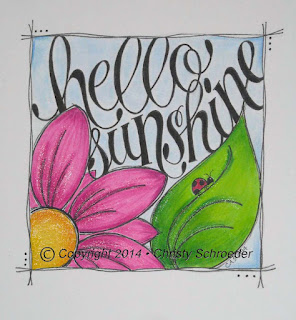As a student of Anthropology at university, my favorite studies were in ethnohistoric research, conducting interviews and learning the immigrant history of families to my small town. When I later chose freelance calligraphy as my career, I never imagined my interest in immigrant research would one day find a pairing with my brushes and paint.
Usually, my calligraphy work is relegated to paper and ink, wedding envelopes and teaching exemplars. But a recent commission allowed me to step into a family's immigrant history, bridging the past with the present.
Last December, a mutual friend put me in touch with Dr. and Mrs. Rindal, of Mt. Vernon, Washington. The Rindals had acquired an old family trunk in need of some restorative painting of old hand lettering.
 |
| Rindal Family trunk |
|
Family stories said that this trunk had traveled with relatives to Ellis Island in the early 1900's when they immigrated to the United States from Norway.
The trunk had been passed through the family, recently coming to rest in a garage, where a few spatters of paint were added to its aged patina, rustic hardware, and bruises showing its use through the past century.
When Mrs. Rindal discovered the trunk was being sold in a family garage sale, she paid the $1.50 requested and rescued it home.
 |
| old shipping tags—"Foreign Baggage" |
 |
| old shipping tags |
 |
| "Rindal" and "North" below |
At some point in time, a skilled hand used a brush and black paint to
write name and destination information on the trunk—the Rindal name,
"Michigan", and "North Amerika".
 |
| "Michigan" |
The lettering had been badly smeared, making two other words barely readable.
 |
| "Amerika" |
It was decided that if I could repaint only the readable words, it would
be an improvement and better than nothing.
But wouldn't it be fun to do a little sleuthing?
 |
| The unknown words |
In natural light and from many different angles, I began trying to make out the faded words. My lettering knowledge allowed me to recognize parts of letters and the familiar curve of the brush used in forming this Roundhand script. The more I looked, the clearer it became that the first word was likely a name—perhaps Randi or Rondi. I jumped on the computer and went to
http://ellisisland.org to see what I could find. There, I could search names, passenger manifests, and dates of immigrant arrivals in the United States. Searching "R. Rindal" turned up a passenger listing for "Randi Rindal" who arrived from Melthus, Norway, on April 28, 1910. From this point, it seemed logical that the other faded word was a city in Michigan. A few of the letters were easier to see than others, especially the very clear capital M at the start (above photo). Back to the computer and a Google search for city names in Michigan beginning with M. This search turned up "Muskegon, Michigan", believed to be the oldest township in that state. Muskegon seemed to match all but a single letter—on the trunk, the "s" was replaced with a "c".
A phone call to the Rindals led to a search through a family history book. Between the book and the Ellis Island records online, names and dates came together enough that we felt confident the name on the trunk was Randi Rindal. And, considering the spelling of Amerika with a "k", it was acceptable to assume that a city in a foreign country may also have been misspelled, so we chose to leave the city as "Muckegon."
The Process
The objective was not an actual restoration of the trunk, but simply to repaint the lettering to be readable without appearing new—the black smearing was left alone as another element of history.
With good natural light, I lightly traced the outline of the letters with a white Fons & Porter chalk pencil, to allow a clear visual for painting.
Black acrylic paint was than applied with a round brush.
As I painted the letters, I could see and feel the original pressure and swell of the brush that made those words over a century ago. Dr. Rindal's grandfather built the trunk; what went through his mind at the time—excitement for his family members who would make the journey? Anxiety or fear of the unknown? And the final touch of labeling the trunk with name and destination—was there joyful anticipation, or sadness at letting a loved one go? Randi was 22 years young when she arrived at Ellis Island—a journey I could never imagine myself taking at such a young age. These are the thoughts that went through my mind with every paint stroke and letter redefined, bridging the distance from Norway and New York in 1910, to the present. This project was never "a job", but rather a privileged look at a wonderful family's history.
 |
| the finished lettering |
Today was delivery day of the finished project. Though I was pleased with the results, Mrs. Rindal's delighted reaction to the rejuvenated painting was even better. With a $1.50 purchase to rescue a family heirloom, history unfolded, family stories were rediscovered, and Randi Rindal has stepped forward in memory. My thanks to the Rindals for allowing me to be part of this.











































